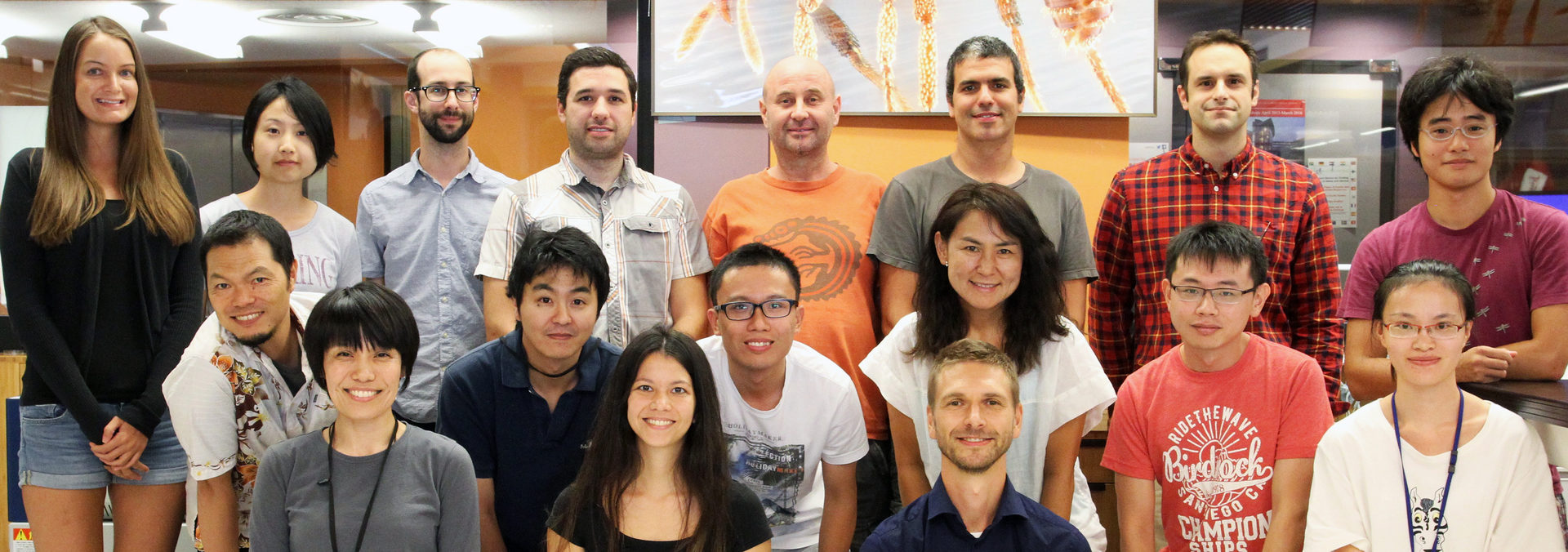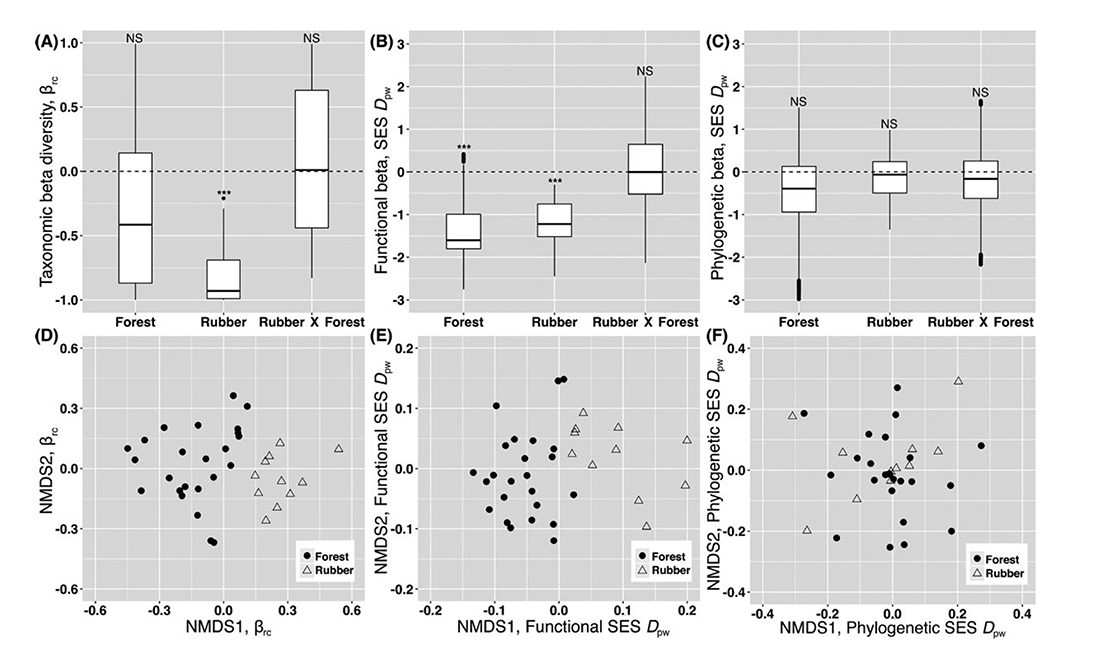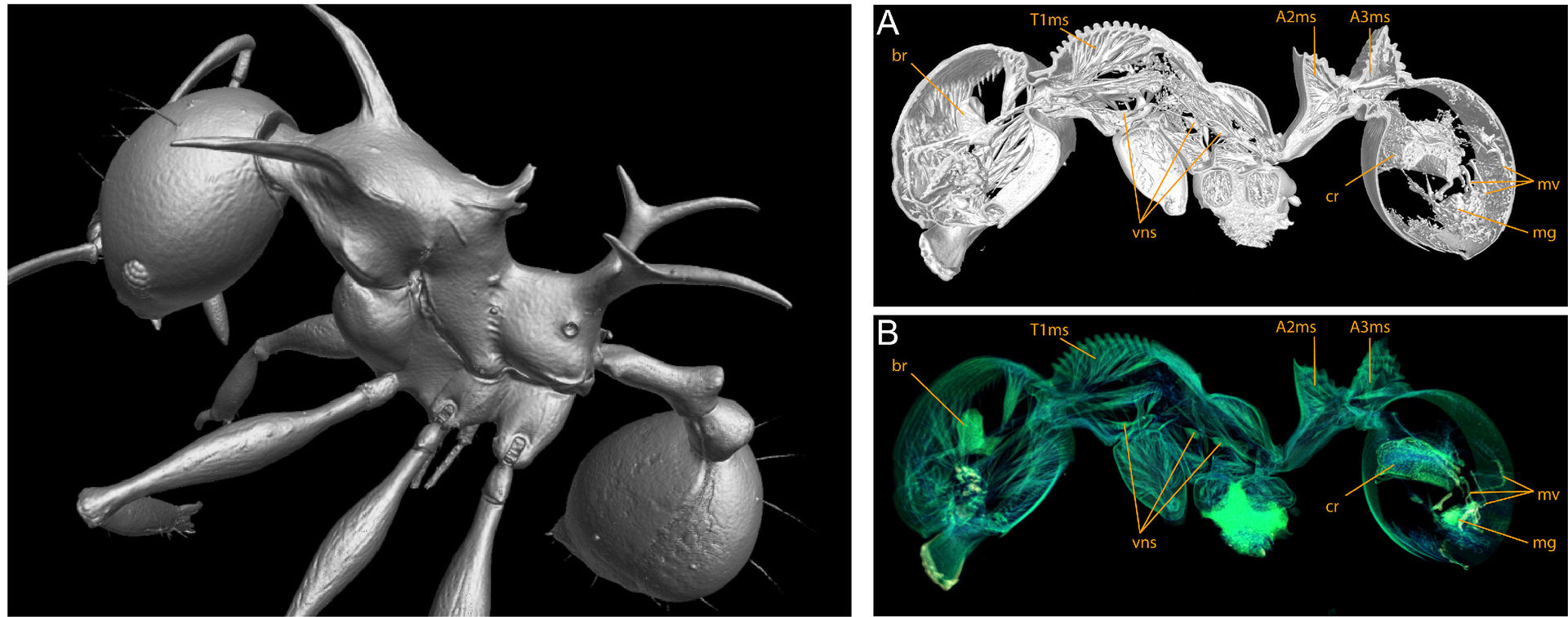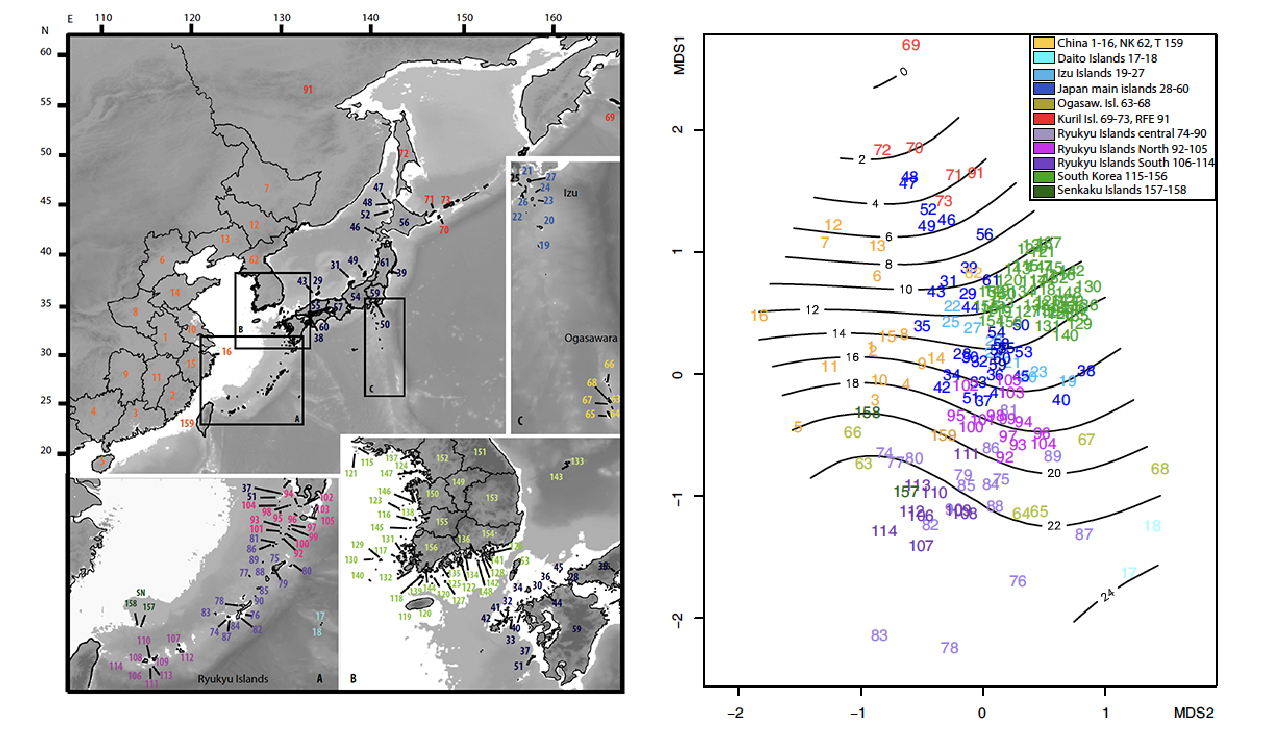FY2016 Annual Report
Biodiversity and Biocomplexity Unit
Assistant Professor Evan P. Economo

Abstract
Our lab seeks to understand how ecological and evolutionary processes interact to generate and regulate biodiversity across spatiotemporal scales and levels of biological organization. Living systems are diverse from gene sequences to organismal morphology to communities and ecosystems. Our goal as biologists is not just to document and catalogue this diversity, but understand the complex interactions and dynamics that generate and sustain biological variation. In FY2016, our research concentrated in four areas; our project on the evolution of the hyperdiverse ant radiations, our Global Ant Biodiversity Informatics (GABI) project which focuses on compiling analyzing global distributions of past and present ant biodiversity, and systematics, ecology, and evolution of Indo-Pacific ant faunas, and the OKEON Chura-Mori Project.
1. Staff
- Dr. Evan P. Economo, Assistant Professor
- Dr. Masashi Yoshimura, Staff Scientist
- Dr. Francisco Hita Garcia, Staff Scientist
- Dr. Georg Fischer, Postdoctoral scholar
- Dr. Clive Darwell, Postdoctoral Scholar
- Dr. Nicholas Ryan Friedman, Postdoctoral Scholar
- Masako Ogasawara, Technician
- Kenneth Lynn Dudley, Technician
- Julia Janicki, Technician
- Takuma Yoshida, Technician
- Izumi Maehira, Research Assistant
- Yasutaka Tamaki, Research Assistant
- Shinji Iriyama, Research Assistant
- Toshihiro Kinjo, Research Assistant
- Kozue Uekama, Research Assistant
- Lindaemiko Iha, Research Assistant
- Ayumi Inoguchi, Research Assistant
- Shoko Suzuki, Research Assistant
- Masafumi Kuniyoshi, Research Assistant
- Natsuki Arashiro, Research Assistant
- Nao Sokei, Research Assistant
- Tracy Lynn Audisio, Visiting Researcher
- Dr. Dan Warren, Visiting Researcher
- Cong Liu, PhD Student
- Yuka Suzuki, PhD Student
- Chisa Oshiro, Research Administrator
2. Activities and Findings
2.1 Global Ant Biodiversity Informatics (GABI) Project
Our understanding of large-scale biodiversity patterns has recently increased dramatically, but available information is strongly biased towards a few groups of vertebrates and plants. Biodiversity patterns in invertebrates, such as insects, are poorly documented despite representing the large majority of species. To address this gap in our knowledge, the Global Ant Biodiversity Informatics (GABI) project has compiled over 250 years of ant research into a single database providing distribution information for all ant species. These data can be used to support all kinds of research and are being used somehow in most of our ant projects. However, the two main analyses we are working on with these data are analyzing global ant diversification patterns across the globe, and a comparison of how global patterns of ant endemism compare with vertebrate groups.
In FY2016 we have continued to grow the dataset, which now constitutes nearly 2 million records. We published a paper describing the efforts (Guenard et al. 2017), and other papers using the data for biogeographic analysis (Wepfer et al. 2016, Economo et al. 2017), and several other analyses are submitted for publication.
Figure 2: One example of the use of GABI data for biogeographic analysis. Wepfer et al. (2016, J. Biogeography) analyzed community composition among regions and islands in East Asia. We found that historical land connections at the last glacial maximum predicted community similarity better than recent land connections. The right anel reflects a nonmetric multidimensional scaling analysis of community composition of the areas in the left panel.
2.2 Evolution, Ecology, and Systematics of Hyperdiverse Ant Radiations
Over evolutionary time lineages evolve in and out of ecological niches, evolve through morphological spaces, and ranges expand and contract in geographic space. These transitions may not be independent, some phenotypes may be better suited to certain ecological habitats, some habitats may promote dispersal and colonization, and colonization of new geographic areas may lead to ecological niche shifts. These ideas form the basis for integrative hypotheses like the taxon cycle. In collaboration with the Knowles lab at the U. of Michigan, we have a funded project to examine the joint dynamics of these transitions in the famously diverse ant genus Pheidole, which contains over 1000 described species and is the dominant ant genus in many tropical ecosystems worldwide. We reconstructed reconstructed a new global phylogeny of the genus and used it to analyze its macroevolution and macroecology, with particular attention to the Old World. We also recently initiated new projects on other hyperdiverse ant radiations, namely the genera Strumigenys (in collaboration with Doug Booher) and Tetramorium (led by Staff Scientist Paco Hita Garcia). Strumigenys is a leaf-litter predator that has evolved a complex trap-jaw mechanism, and we are examining the evolution of this trait in time and space. In Tetramorium, we are analyzing biogeography, morphological evolution, and transitions between ecological generalism and specialism. Specimen work and RAD-sequencing for phylogenomics reconstruction is ongoing for these groups.
In FY2016, we published novel quantitative methods for testing complex biogeographic theory such as the taxon cycle (Sukumaran et al. 2016). We also published several taxonomic works on interesting spinescent groups in New Guinea (Sarnat et al 2016, Fischer et al 2016). One of those species, Pheidole drogon, has been selected as one of the top 10 species of 2017.
2.3 Biodiversity, Biogeography, and Evolutionary Ecology of Indo-Pacific Ant Faunas
Ants are among the most ubiquitous and ecologically dominant animal groups. Over millions of years, ant biodiversity has evolved and dispersed from Asia and Australia through the vast network of Pacific islands. More recently, humans have unintentionally introduced many species from around the globe into the Pacific. We seek to understand the historical and contemporary processes that regulate ant biodiversity over time. In FY2016, we continued a series of published works on the Indo-Pacific ant faunas, including a new paper on the biogeography of ant species-area curves in the Pacific (Economo et al. 2017) . We analyzed taxonomoic, functional, and phylogenetic ant diversity in rubber plantations in tropical China (Liu et al 2016, Figure 2). In addition, we published a new method for the statistical analysis of island communities (Lasky et al. 2017). We also continued making progress on our high-throughput RAD-sequencing of the Fijian ant fauna. We expect to complete this dataset in FY2017. 
Figure 2: Responses of ant beta diversity across taxonomic, functional, and phylogenetic biodiversity dimensions after conversion to rubber plantation in Xishuangbanna, Yunnan, China (from Liu et al. 2017, Ecological Monographs)
2.4 OKEON Chura-Mori Project
In collaboration with the Mikheyev unit here at OIST, in FY2013 we initiated a major initiative called the OKEON Chura-Mori Project (OKEON stands for Okinawa Environmental Observation Network). The goal is to develop an observation system to measure and monitor the environment of Okinawa, in collaboration with the people of Okinawa. The primary scientific goal is to develop long-term space-time data series from sites across the island.
After the establishment of 24 sites at the end of FY2015, FY2016 was our first full year of arthropod sampling at all the sites. We also finished deployment of the whole network of camera traps and acoustic devices. We have also been broadening the activities and partners, we now have over 80 partners in the project. See the OKEON website for more on our activities.
2.4 X-Ray Computed Tomography for Entomology
Since the earliest biological studies, description and quantification of biological structures has been a basic goal of biology as well as a first step toward deeper understanding of ecological and evolutionary processes. In Entomology, the primary imaging tools have traditionally been optical microscopy and SEM, which are essential for certain tasks and allow us to see complex structures well. But these are limited in our ability to quantitatively characterize complex shapes, surfaces, and textures. X-Ray CT has the potential to complement existing tools by providing a digital 3D image of the interior and exterior of the organism. These images can be manipulated, dissected, measured, and quantified. We have been developing imaging and post-processing techniques to better quantify the functional morphology of ants, including both external and internal structures. In FY2016 we published a series of papers exploring the applications of microCT to ant systematics research (Sarnat et al. 2016, Fischer et al. 2016, Hita Garcia et al. 2017), and have initiated new collaborative projects on the evolution of ant functional morphology.

Figure 4: X-Ray microtomography of ant species. Left, Pheidole drogon, a new species recently described by our lab (Sarnat et al. 2016) that was chosen as one of the top 10 new species of the year by SUNY-ESF. Right, a new species of Terataner (Hita Garcia et al. 2017) , used as a case study to highlight the potential of the technology for ant biology and systematics.
3. Publications
3.1 Journals
- Ross, S. R. P-J., Hassall, C., Hoppitt, W. J. E., Edwards, F. A. Edwards, D. P., Hamer, K. C. Incorporating intraspecific trait variation into functional diversity: Impacts of selective logging on birds in Borneo. Methods in Ecology and Evolution, doi: 10.1111/2041-210X.12769 (2017).
- Matysioková, B., Friedman, N. R., Turčoková, L., Remeš, V. The evolution of feather coloration and song in Old World orioles (genus Oriolus). Journal of Avian Biology, doi: 10.1111/jav.01175 (2017).
- Hita Garcia, F., Mbanyana, N., Audisio, T. L., Alpert, G. D. Taxonomy of the ant genus Nesomyrmex Wheeler (Formicidae, Myrmicinae) in the Afrotropical region, with a review of current species groups and description of a new species of the N-angulatus group from Mozambique. European Journal of Taxonomy, doi: 10.5852/ejt.2017.258 (2017).
- Hita Garcia, F., Fischer, G., Liu, C., Audisio, T. L., Alpert, G. D., Fisher, B. L., Economo, E. P. X-Ray microtomography for ant taxonomy: An exploration and case study with two new Terataner (Hymenoptera, Formicidae, Myrmicinae) species from Madagascar. PLoS ONE, doi: 10.1371/journal.pone.0172641 (2017).
- Guénard, B., Weiser, M. D., Gómez, K., Narula, N., Economo, E. P. The Global Ant Biodiversity Informatics (GABI) database: synthesizing data on the geographic distribution of ant species (Hymenoptera: Formicidae). Myrmecological News (2017).
- Wepfer, P. H., Guénard, B., Economo, E. P. Influences of climate and historical land connectivity on ant beta diversity in East Asia. Journal of Biogeography, doi: 10.1111/jbi.12762 (2016).
- Sukumaran, J., Economo, E. P., Knowles, L. L. Machine Learning Biogeographic Processes from Biotic Patterns: A New Trait-Dependent Dispersal and Diversification Model with Model Choice By Simulation-Trained Discriminant Analysis. Systematic Biology, doi: 10.1093/sysbio/syv121 (2016).
- Sarnat, E. M., Fischer, G., Economo, E. P. Inordinate Spinescence: Taxonomic Revision and Microtomography of the Pheidole cervicornis Species Group (Hymenoptera, Formicidae). PLoS ONE, doi: 10.1371/journal.pone.0156709 (2016).
- Liu, C., Guénard, B., Blanchard, B., Peng, Yan-Q., Economo, E. P. Reorganization of taxonomic, functional, and phylogenetic ant biodiversity after conversion to rubber plantation. Ecological Monographs, doi: 10.1890/15-1464.1 (2016).
- Lasky, J. R., Keitt, T. H., Weeks, B. C., Economo, E. P. A hierarchical model of whole assemblage island biogeography. Ecography, doi: 10.1111/ecog.02303 (2016).
- Janicki, J., Narula, N., Ziegler, M., Guénard, B., Economo, E. P. Visualizing and interacting with large-volume biodiversity data using client–server web-mapping applications: The design and implementation of antmaps.org. Ecological Informatics, doi: 10.1016/j.ecoinf.2016.02.006 (2016).
- Jaitrong, W., Guénard, B., Economo, E. P., Buddhakala, N., Yamane, S. A Checklist of known ant species of Laos (Hymenoptera: Formicidae). Asian Myrmecology, doi: 10.20362/am.008019 (2016).
- Friedman, N. R., Remeš, V. Ecogeographical gradients in plumage coloration among Australasian songbird clades. Global Ecology and Biogeography, doi: 10.1111/geb.12522 (2016).
- Fischer, G., Sarnat, E. M., Economo, E. P. Revision and Microtomography of the Pheidole knowlesi Group, an Endemic Ant Radiation in Fiji (Hymenoptera, Formicidae, Myrmicinae). Plos One, doi: 10.1371/journal.pone.0158544 (2016).
- Economo, E. P., Janda, M., Guénard, B., Sarnat, E. Assembling a species–area curve through colonization, speciation and human-mediated introduction. Journal of Biogeography, doi: 10.1111/jbi.12884 (2016).
3.2 Books and Other One-Time Publications
- Roberts, D., Alonzo, M., Wetherley, E. B., Dudley, K. L., Dennison, P. E. Multiscale Analysis of Urban Areas Using Mixing Models. Integrating Scale in Remote Sensing and GIS, doi: 10.1201/9781315373720-10 (2017).
- Yoshimura, M. Ants of Okinawa City and the OKEON Chura-mori Project. Nature of Okinawa City, the entrance of Yambaru (2016).
3.3 Oral and Poster Presentations
- Economo, E. P. Informatics approaches to understanding macroecology and macroevolution, The 64th Annual Meeting of the Ecological Society of Japan, Shinjuku, Japan, Mar 15 (2017).
- Friedman, N. R. Listening to ecosystems: data-rich acoustic monitoring through landscape-scale sensor networks, The 64th Annual Meeting of the Ecological Society of Japan, Shinjuku, Japan, Mar 15 (2017).
- Shizuki, M., Yoshida, T. Phenology and natural enemies of Scolytus esuriens Blandford (Coleoptera: Scolytidae) on the Hokkaido University Campus, Phenology and natural enemies of Scolytus esuriens Blandford (Coleoptera: Scolytidae) on the Hokkaido University Campus FY2016, Sapporo, Japan, Jan 18 (2017).
- Janicki, J., Narula, N., Ziegler, M., Guénard, B., Economo, E. P. antmaps.org: An interactive client-server mapping application for visualizing the ants of the world, ICE 2016 XXV International Congress of Entomology, Orland, USA, Sep 30 (2016).
- Economo, E. P., Guénard, B., Weiser, M., Narula, N. Reconciling global macroecological pattern and macroevolutionary processes in ant biodiversity, ICE 2016 XXV International Congress of Entomology, Orland, USA, Sep 27 (2016).
- Hita Garcia, F., Economo, E. P. Evolution, biogeography, and diversification of the genus Terataner, ICE 2016 XXV International Congress of Entomology, Orland, USA, Sep 27 (2016).
- Yoshimura, M., Yoshida, T., Ogasawara, M., Economo, E. P. OKEON Chura-mori Project: A new environmental monitoring project in Okinawa, Japan, ICE 2016 XXV International Congress of Entomology, Orlando, USA, Sep 26 (2016).
- Liu, C., Guénard, B., Blanchard, B., Peng, Yan-Q., Economo, E. P. Reorganization of taxonomic, functional, and phylogenetic ant biodiversity after conversion to rubber plantation, ICE 2016 XXV International Congress of Entomology, Orland, USA, Sep 26 (2016).
- Economo, E. P., Guénard, B., Liu, C. Invertebrate conservation in a changing world: linking local and global approaches, XVII International Colloquium on Soil Zoology and XIV International Colloquium on Apterygota, Nara, Japan, Aug 26 (2016).
- Yoshimura, M., Yoshida, T., Ogasawara, M., Economo, E. P. OKEON Chura-mori Project:a new terrestrial environmental monitoring project under the cooperation with Okinawan society, The 53rd Annual Meeting of The Biological Society of Okinawa, Nishihara, Japan, May 28 (2016).
- Economo, E. P. The macroecology of ant mutualisms, Ants 2016, Munich, Germany, May 06 (2016).
4. Meetings and Events
4.1 Seminar, “Three talks on Ecotoxicology”
- Date: March 24, 2017
- Venue: OIST Center Building
- Speaker: Dr. Shosaku Kashiwada, Dr. Yuichi Iwasaki, and Ms. Chisato Kataoka (Toyo University)
4.2 Seminar, “From Cretaceous to community: Understanding the assembly and diversity of a regional biota”
- Date: March 13, 2017
- Venue: OIST Campus Lab3
- Speaker: Dr. Paul Oliver (Australian National University)
4.3 Seminar, “When individuals matter: Biodiversity and the impacts of logging in Borneo”
- Date: August 4, 2016
- Venue: OIST Campus Lab3
- Speaker: Mr. Samuel RP-J Ross (University of Leeds, U.K.)




